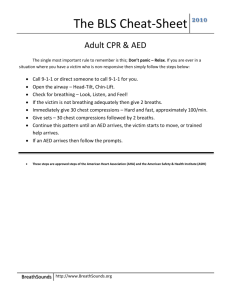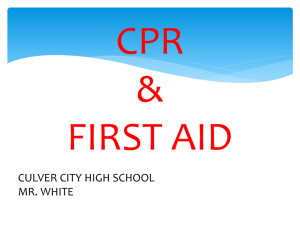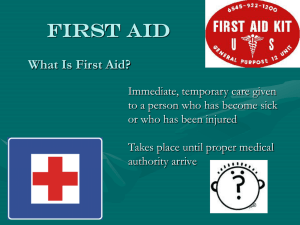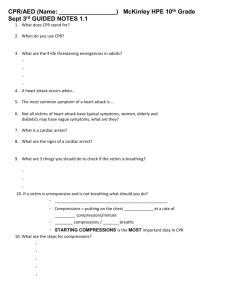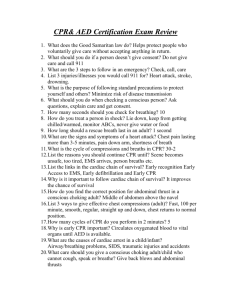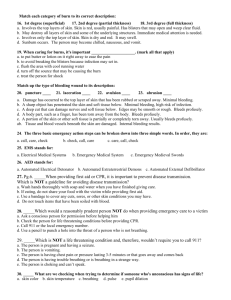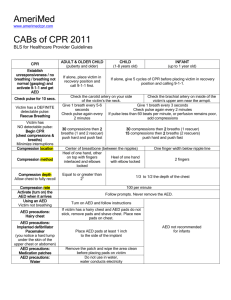Learn to Save a Life
advertisement
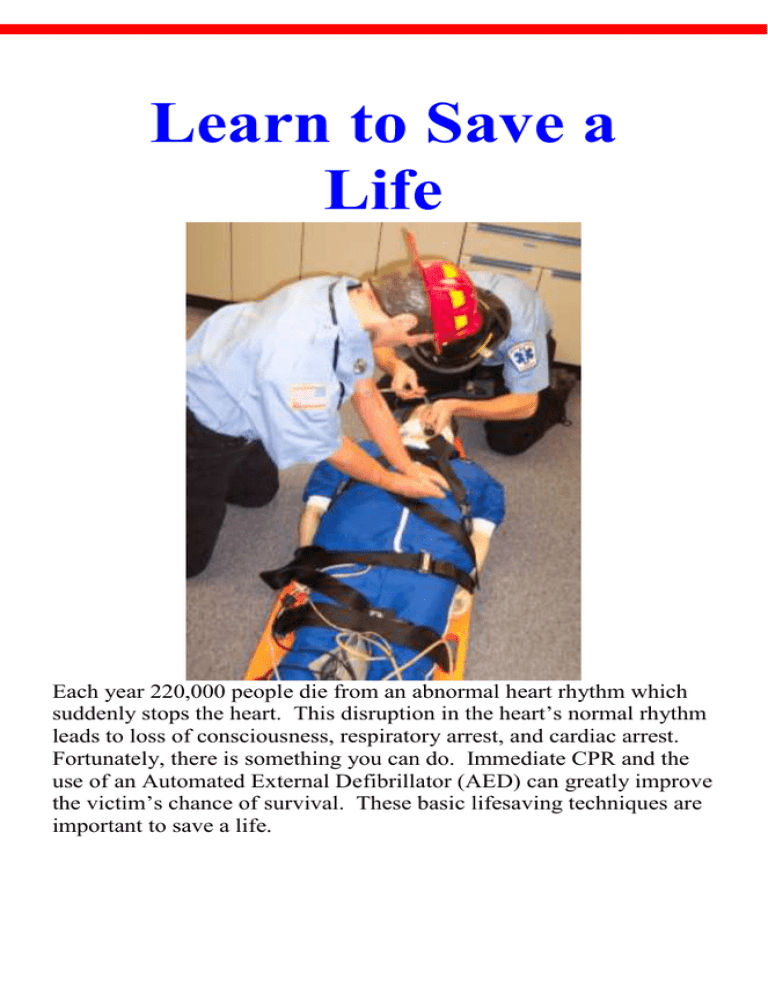
Learn to Save a Life Each year 220,000 people die from an abnormal heart rhythm which suddenly stops the heart. This disruption in the heart’s normal rhythm leads to loss of consciousness, respiratory arrest, and cardiac arrest. Fortunately, there is something you can do. Immediate CPR and the use of an Automated External Defibrillator (AED) can greatly improve the victim’s chance of survival. These basic lifesaving techniques are important to save a life. Administering CPR 1 The first step is to make sure that the area is safe for you to enter. While approaching the victim, look to see if there are any potential hazards which could harm you such as electrical cords, slick surfaces, falling debris, hazardous materials, and violent situations. Remember: You can’t help the victim if you get injured! 2 Check the victim’s responsiveness by shaking their shoulders gently and shouting, “Are you ok?” If the victim does not respond, call 911 or have someone else call 911 and get an AED. Check the victim by shaking and shouting. 3 After calling 911, open the victim’s airway. Place one hand on the victim’s forehead and your other hand on the chin. Tilt the head back as you lift the chin. This will move the victim’s tongue away from the back of their mouth and will open their airway. Open the airway with a head-tilt chin-lift maneuver 4 Check to see if the victim is breathing. As you keep the airway open, kneel down to check if you feel or hear any breath and watch to see if the chest rises and falls. You should check for about 10 seconds to see if they are breathing. 5 Look, listen, and feel for breathing. If the victim is not breathing, you need to breathe for them. Take a deep breath and make a seal with your mouth over theirs. Pinch the nostrils to keep air from escaping. Breathe into the victim for 1-2 seconds while watching Deliver each breath until the chest rises. for the chest to rise. When the chest rises, stop breathing into their mouth and allow the victim to fully exhale. Then, deliver a second breath. If the chest does not rise, reposition the victim’s head and try to breathe again. Remember: Deliver each breath slowly to prevent air from entering the victim’s stomach! 6 Now, check the victim to see if their heart is beating by looking for these signs of circulation: Coughing Moving Breathing 7 If the victim has no signs of circulation, you need to start chest compressions. Remove clothing from the victim’s chest and find the bottom of their breastbone. Place one hand 2 finger-widths above the bottom of the Place your hand 2 finger-widths above the bottom of the breastbone. breastbone and then place your other hand on top of the first. Join your fingers together and pull your fingers back so that only the heel of your hand is in contact with the victim’s chest. Lock your elbows and position your shoulders above your hands. 8 Press down on the victim’s chest about 1 ½ to 2 inches. If you don’t press hard enough, you won’t deliver an effective compression. Compress the victim’s chest at a rate of 100 compressions a 1 ½ - 2” Press the chest down 1 ½ - 2”. minute. Count out-loud as you deliver chest compressions. After 15 compressions stop and deliver 2 breaths. This is one cycle of CPR. 9 Repeat this process 4 times and then stop and recheck the victim to see if they have any signs of circulation. Then, resume CPR until help arrives. Using the AED 1 Once the AED is at the victim’s side, the first step is to open the cover and turn on the machine. This allows the machine to complete a self-test and will begin the voice prompts that will direct your actions. One CPR Cycle 15 compressions and 2 breaths Power Button The first step is to turn on the AED. Special Considerations for AED Use Remove the victim from water and dry the victim’s chest before applying the AED pads if necessary. Position the AED pads away from any implanted devices in the victim’s chest which could impede the flow of electricity. Take off any medication patches the victim is wearing if they interfere with pad placement. 2 The machine will prompt you to connect the electrodes to the victim’s bare chest. One pad goes on the right side of the victim’s chest, just below their collarbone. The other pad goes on the side of the victim’s chest, just below their left armpit. This placement allows the energy to travel from one pad to the other by passing through the victim’s heart. After the pads have been attached to the victim’s chest, plug the pads into the AED. 3 The AED patches show proper placement. Proper pad placement on the victim’s chest. The AED will then Shock begin to analyze the heart button rhythm of the victim. If a shockable rhythm is found (see “What does an AED do?”), the machine will automatically charge and it will direct you to push the The AED will prompt you to press the shock button. Remember: shock button.. Do not touch the victim during the “analyze” or “shock” phase! 4 Before pressing the shock button, make sure that you and all bystanders are clear. Then, shout, “Clear!” and press the shock button to deliver the shock. The victim’s muscles may jerk when the shock is delivered, this is normal. Clear the victim before pressing the shock button. 5 The AED then analyzes the victim’s heart rhythm again. If a shockable rhythm is found, repeat steps 3 and 4 until you have delivered 3 shocks in a row or the AED finds the victim’s heart is no longer in a shockable rhythm. If the AED finds a rhythm that cannot be shocked, or you give 3 shocks in a row, the AED will tell you to recheck the victim for breathing and signs of circulation. If signs of circulation are found, continue to watch your victim and check every 30 seconds to make sure their heart is still beating. If signs of circulation are not found, then do CPR for one minute. 6 Every minute, the AED will analyze the victim’s heart rhythm and voice prompts will instruct you. What does an AED do? The AED analyzes the heart rhythm and looks for an abnormal rhythm called ventricular fibrillation. Ventricular fibrillation occurs when individual muscle cells in the pumping chambers of the heart contract chaotically. The chaotic contractions do not circulate blood to the victim’s body and if left untreated, the victim will die. The AED delivers energy to the heart to stop all activity and tries to reset the heart so the heart’s pacemaker cells can resume a normal heart rhythm. CPR and AED Steps CPR Shake and Shout, if the victim does not respond, call 911. Open the airway and check for breathing. If not breathing, give 2 breaths and then check for circulation. If no circulation, start chest compressions at a rate of 100 each minute. Give 15 compression and 2 breaths each cycle. AED Turn on AED. Attach AED pads. Analyze the heart rhythm. Stay clear. Shock if directed. Follow voice prompts. Clip out this reminder card and carry it with you. This brochure should provide the reader with a basic knowledge in the proper steps for providing care to a victim of cardiac arrest. It does not replace any formal training program. Readers are strongly encouraged to take a CPR and AED class in order to become certified in CPR and AED use. For information about CPR and AED classes contact: American Heart Association 877-AHA-4CPR americanheart.org American Red Cross 515-232-5104 redcross.org Mercy Nurse 515-2HEALTH mercydesmoines.org
